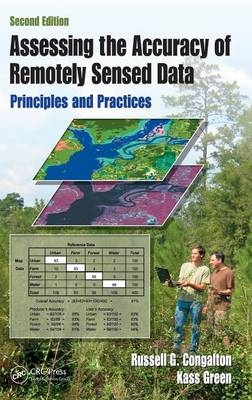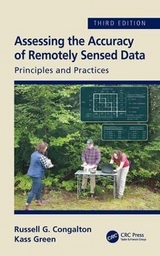
Assessing the Accuracy of Remotely Sensed Data
Crc Press Inc (Verlag)
978-1-4200-5512-2 (ISBN)
- Titel erscheint in neuer Auflage
- Artikel merken
Accuracy assessment of maps derived from remotely sensed data has continued to grow since the first edition of this groundbreaking book. As a result, the much-anticipated new edition is significantly expanded and enhanced to reflect growth in the field. The new edition features three new chapters, including:
Fuzzy accuracy assessment
Positional accuracy
Case study: Mapping land cover and land use in the Florida panhandle
The authors provide a complete presentation of how to assess the positional accuracy of a map along with a discussion of the impact of positional accuracy on thematic accuracy. They also include a more thorough discussion of the special sampling issues that must be considered to effectively assess change.
Complete with a 16-page color insert, this second edition continues to provide a complete guide to designing and conducting a state-of-the-art accuracy assessment.
University of New Hampshire, Durham, USA The Alta Vista Company, Berkeley, California, USA
Introduction
Why Map?
Why Assess the Accuracy of a Map?
Types of Map Accuracy Assessment
Critical Steps in Accuracy Assessment
Organization of the Book
The History of Map Accuracy Assessment
How Maps Are Made
History of Accuracy Assessment
Positional Accuracy
What Is Positional Accuracy?
What Are the Common Standards for Positional Accuracy?
Positional Accuracy Assessment Design and Sample Selection
How Is Positional Accuracy Analyzed?
Summary
Appendix 3.1: Determining the Required Sample Size
Thematic Accuracy
Non-Site-Specific Assessments
Site-Specific Assessments
Sample Design Considerations
What Are the Thematic Map Classes to Be Assessed?
What Is the Appropriate Sample Unit?
How Many Samples Should Be Taken?
How Should the Samples Be Chosen?
Final Considerations
Reference Data Collection
What Should Be the Source of the Reference Data?
How Should the Reference Data Be Collected?
When Should the Reference Data Be Collected?
Ensuring Objectivity and Consistency
Basic Analysis Techniques
Kappa
Margfit
Conditional Kappa
Weighted Kappa
Compensation for Chance Agreement
Confidence Limits
Area Estimation/Correction
Analysis of Differences in the Error Matrix
Errors in the Reference Data
Sensitivity of the Classification Scheme to Observer Variability
Inappropriateness of the Remote Sensing Data Employed to Make the Map
Mapping Error
Summary
Appendix 8.1: Wrangell-St. Elias National Park and Preserve: Land Cover Mapping Classification Key
Fuzzy Accuracy Assessment
Expanding the Major Diagonal of the Error Matrix
Measuring Map Class Variability
The Fuzzy Error Matrix Approach
Summary
Case Study
Accuracy Assessment for the NOAA Next-Generation C-CAP Pilot Project
Overview of the Case Study
Design of the Accuracy Assessment
Data Collection
Analysis
Lessons Learned
Appendix 10.1: Decision Rules for the Classification Scheme
Advanced Topics
Change Detection
Multilayer Assessments
Appendix 11.1: Class Descriptions of the 2005 NLCD Land Cover
Bibliography
Index_
| Erscheint lt. Verlag | 12.12.2008 |
|---|---|
| Zusatzinfo | 8-page 4C insert; 101 equations; 36 Tables, black and white; 31 Illustrations, black and white |
| Verlagsort | Bosa Roca |
| Sprache | englisch |
| Maße | 156 x 234 mm |
| Gewicht | 431 g |
| Themenwelt | Naturwissenschaften ► Geowissenschaften ► Geografie / Kartografie |
| ISBN-10 | 1-4200-5512-7 / 1420055127 |
| ISBN-13 | 978-1-4200-5512-2 / 9781420055122 |
| Zustand | Neuware |
| Informationen gemäß Produktsicherheitsverordnung (GPSR) | |
| Haben Sie eine Frage zum Produkt? |
aus dem Bereich



